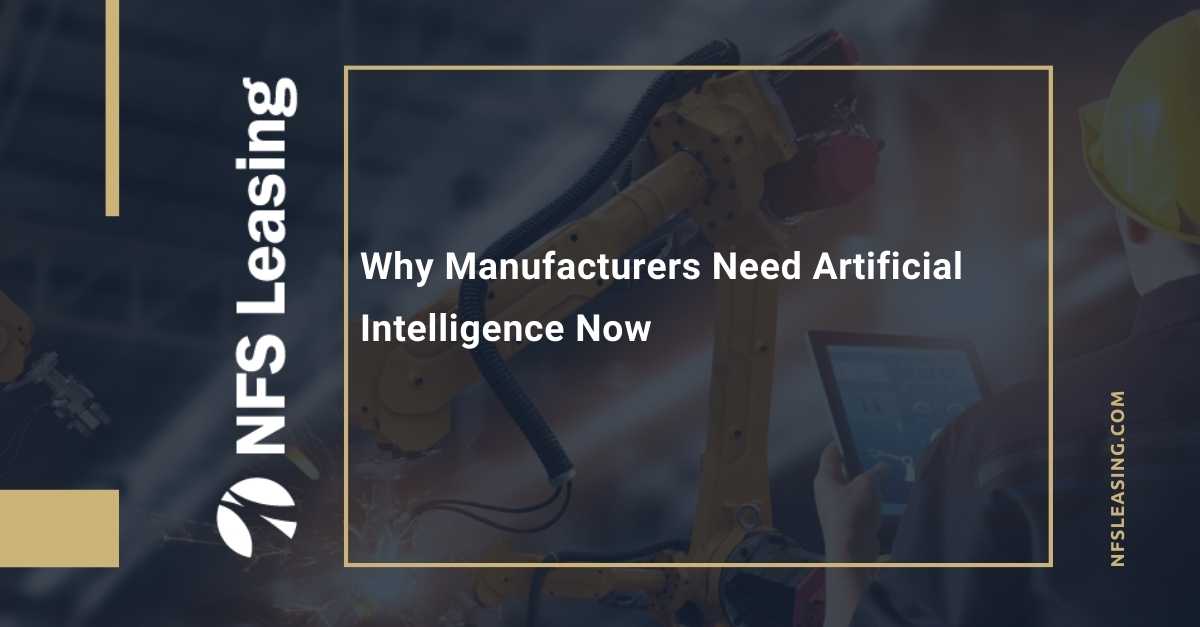
by Dean Oliver, NFS Leasing Principal. Published in MonitorDaily.
As leasing and financial companies, when we hear the term artificial intelligence (AI), the first thing many of us think about is software and big data applications.
But the truth is many of our customers and primary lines of business are using AI in both obvious and not so obvious ways. It’s an opportunity for us to finance high value, essential use equipment for customers, especially for manufacturers.
And COVID-19 is only accelerating the pace of AI spending.
AI Investment
Global investment in AI was $37.5 billion in 2019, according to IDC. The same IDC study projects 160% growth in AI investments by 2023 up to $97.9 billion.
Most of the funds invested in AI go to technology. That includes software, hardware, or robotics, and smart machinery. Deloitte’s State of AI in The Enterprise study states that AI adopters tend to buy more than build (Study, p.2). Fifty percent either buy an existing AI package or buy more than build (Study. p.11). That’s lots of expensive high-tech equipment to finance.
It’s still early implementing AI into business operations, even at technology companies. The Deloitte study found that 27% of their enterprise executives are just starting to use AI in their businesses (Study, p.5). A recent Forbes article on MIT’s study on Intelligent Organizations states that 62% of Enterprise organizations increased their AI spending last year. Tech analysts expect the trend to continue even during economic uncertainty.
According to the Deloitte study (p.9), the top applications companies use AI to improve on are [in order]: IT, Cybersecurity, Production and Manufacturing, and Engineering and Product Development.
The big takeaway is that spending on AI is like spending on software in the ’90s. It’s early. The only thing that happens once companies get started on AI spending is that it continues and grows each year.
Artificial Intelligence in Manufacturing
If you finance equipment for manufacturers, then you know nothing is more important to them than their line production equipment. If it goes down, they produce no product. Emerson reports from their manufacturing study that unplanned downtime costs industrial manufacturers up to $50 billion annually.
And AI has a solution for this.
Predictive maintenance for line equipment uses AI-based algorithms and machine learning to predict mechanical malfunctions, both for prevention and to extend the useful life of the equipment. This is a key benefit if one of your concerns is how essential the AI is to the equipment. Prevention and extending useful life save customers billions of dollars. You get a higher value piece of equipment in return if you’ve done a true lease or you have a repossession.
The predictive nature of AI-based algorithms extends to measuring product quality and eliminating defects. CIO Magazine cites how quality control and production data & analytics are 2 areas where AI is used both right now and for future planning.
One of the upsides of AI is also a downside; generative design. Generative design uses Artificial Intelligence and design principles that a piece of heavy machinery like an installation robot needs to have and it presents options for new designs for future models. Better quality, more expensive essential equipment is a win/win and the upside. The potential downside is obsolescence for older models, especially for collateral and story lenders. You may have to readjust your collateral values.
COVID-19 Speeds Up the Trend
Although the pandemic is a huge financial disruption, the virus is giving companies reason to spend more and faster on AI. Why? Because machines and automation can complete some of the work that a group used to do. A group that has to maintain social distance may not be at the same location. AI systems in software, analytics, or production can help maintain production levels when company staff can’t be there in person.
The public sector and healthcare are already spending more on AI during virus time, according to Real-Time Insights and IDC. Hospitals are using it for testing and diagnostics in the same way that manufacturers need to use AI for quality control and predictive maintenance.
The same enterprises I’ve mentioned in the IDC and Deloitte studies must prepare for the possibility of longer-term remote work. That means more spending on IT and cybersecurity since at home networks are notoriously insecure compared to business networks. Meanwhile, manufacturers are using reduced production times as an ideal opportunity to add preventive or analytics systems to their lines.
The disruption to the way we work, where we work, and what we produce that we are now facing now means that Artificial Intelligence will only become more important in the future. Lessors will have the challenge of valuing this new equipment. Yet, it’s also a huge opportunity across industries to finance expensive essential equipment for your customers.
Contact us if you want to adopt AI for your manufacturing business or discuss new ways you and your company have been using AI.

